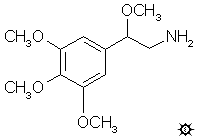
#17 BOM
beta-METHOXYMESCALINE; 3,4,5,beta-TETRAMETHOXYPHENETHYLAMINE
|
| [3D .mol structure] |
A solution of LAH (50 mL of 1 M solution in THF) was cooled, under He, to 0 °C with an external ice bath. With good stirring there was added 1.25 mL 100% H2SO4 dropwise, to minimize charring. This was followed by the addition of 6 g of solid 1-methoxy-2-nitro-1-(3,4,5-trimethoxyphenyl)ethane over the course of 2 min. There was some gas evolution. After 5 min additional stirring, the temperature was brought up to a reflux with a heating mantle. There was a gentle gas evolution for a few minutes, followed by an exothermic reaction with vigorous gas evolution. Once everything had settled down, the reaction mixture was held at reflux temperature for an additional 2 h. The excess hydride was destroyed by the addition of IPA and 15% NaOH was added to convert the inorganic salts to a loose white filterable mass. The reaction mixture was filtered, and the filter cake washed thoroughly with THF. The combined filtrate and washes were stripped of solvent under vacuum which provided a red-brown liquid. This was dissolved in dilute H2SO4 and washed with 3x75 mL CH2Cl2. After making the aqueous phase basic with NaOH, it was extracted with 2x100 mL CH2Cl2. The pooled extracts were stripped of solvent under vacuum, and the colorless residue distilled at 120-150 °C at 0.3 mm/Hg. There was obtained 2.8 g of a colorless oil which was dissolved in 30 mL IPA and neutralized with concentrated HCl, allowing the spontaneous formation of the hydrochloride salt. This was diluted with 75 mL anhydrous Et2O, yielding 2.8 g 3,4,5,beta-tetramethoxyphenethylamine hydrochloride (BOM) as a white crystalline product. This had a mp of 198.5-199.5 °C. Anal. (C12H20ClNO4) C,H.
DOSAGE: greater than 200 mg.
DURATION: unknown.
EXTENSIONS AND COMMENTARY: There are some indicators of central activity with assays involving both the 120 milligram and the 180 milligram levels, but nothing that can be rated as over a plus one. It can be seen with the two active members of the BOX series (BOD and BOB) that the potency is about equal to, or a little more (up to a factor of maybe x2), than the analogue without the methoxyl group on the aliphatic chain. If this formula were to hold in the relationship between mescaline and BOM, the active level might well be in the 200-400 milligram range. But at the moment, it remains unknown.
Again, the name of the compound (BOM) is from the RBO-S prefix of this family (from benzyl + oxy), plus the RMS of mescaline (which has provided the ring substitution pattern).
| [ |
[Main Index] | [Forward |

